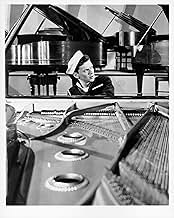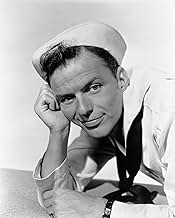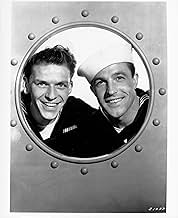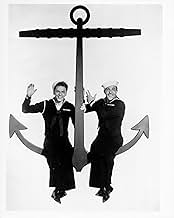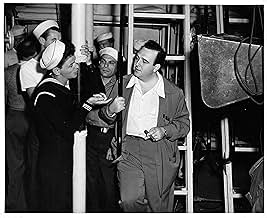NOTE IMDb
7,0/10
9,8 k
MA NOTE
Deux marins en congé à Hollywood tente d'aider une figurante à devenir une star de la musique.Deux marins en congé à Hollywood tente d'aider une figurante à devenir une star de la musique.Deux marins en congé à Hollywood tente d'aider une figurante à devenir une star de la musique.
- Réalisation
- Scénario
- Casting principal
- Récompensé par 1 Oscar
- 5 victoires et 4 nominations au total
Rags Ragland
- Police Sergeant
- (as 'Rags' Ragland)
Carlos Ramírez
- Carlos
- (as Carlos Ramirez)
Résumé
Reviewers say 'Anchors Aweigh' is a classic MGM musical with Gene Kelly, Frank Sinatra, and Kathryn Grayson. It features memorable dance sequences, vibrant Technicolor, and innovative camera work. Themes of love, friendship, and ambition are explored. Songs by Jule Styne and Sammy Cahn enhance the charm. Despite some criticisms of length and pacing, the film is celebrated for its entertainment value and historical significance.
Avis à la une
Released some months before the end of the war, "Anchors Aweigh" is one of Gene Kelly's major musical triumphs of the forties
Under the direction of George Sidney, it had the benefits of a pleasant score, andbest of allthe services of Gene Kelly in his first true starring role at MGM The year before, in Columbia's "Cover Girl," he had revealed an innovative approach to dance on the screen, a light but agreeable singing voice, and considerable charm In "Anchors Aweigh," although he was billed under Frank Sinatra and Kathryn Grayson, he was laying the solid groundwork for his most revealing years at MGM
The film's story, a kind of dry run for "On the Town" four years later, follows sailors Kelly and Sinatra on shore leave, spend their holiday in Hollywood, where they become involved in the affairs of an aspiring singer (Grayson) and her little nephew (Dean Stockwell).
Grayson, it appears, has her heart set on an audition with conductor-pianist Jose Iturbi She gets the audition, of course; Kelly gets Grayson after some misunderstandings; and Sinatra, has forgotten to be shy, and has lost his heart to a girl from Brooklyn (Pamela Britton).
The plot is conventional for the period but, regrettably, it now seems barely tolerable But there is Gene Kelly, who dominates the movie with his agreeable personality Perhaps he grins too much, but when is permitted to dance, the film finally lifts off the ground
"I Begged Her," his early song and dance with Sinatra, is amusing and slightly absurd, in which he imagines himself as a bandit chieftain in a Spanish courtyard, courting maiden Grayson with a flamboyant flamenco dance and some athletic leaps He also does a charming Mexican dance with little Sharon McManus in the square of a Mexican settlement in Los Angeles
The highlight of the movie, however, is Kelly's famous dance with the cartoon character Jerry the Mouse (of "Tom and Jerry" fame). Delightful and innovative, it skillfully combines live action and animation in its tale of a sad mouse king who refuses to allow music in his kingdom until Kelly, a sailor in the "Pomeranian Navy," wearing a striped shirt and a beret, shows him how to dance "Look at me, I'm dancin'!" says the gleeful mouse king...
Under the direction of George Sidney, it had the benefits of a pleasant score, andbest of allthe services of Gene Kelly in his first true starring role at MGM The year before, in Columbia's "Cover Girl," he had revealed an innovative approach to dance on the screen, a light but agreeable singing voice, and considerable charm In "Anchors Aweigh," although he was billed under Frank Sinatra and Kathryn Grayson, he was laying the solid groundwork for his most revealing years at MGM
The film's story, a kind of dry run for "On the Town" four years later, follows sailors Kelly and Sinatra on shore leave, spend their holiday in Hollywood, where they become involved in the affairs of an aspiring singer (Grayson) and her little nephew (Dean Stockwell).
Grayson, it appears, has her heart set on an audition with conductor-pianist Jose Iturbi She gets the audition, of course; Kelly gets Grayson after some misunderstandings; and Sinatra, has forgotten to be shy, and has lost his heart to a girl from Brooklyn (Pamela Britton).
The plot is conventional for the period but, regrettably, it now seems barely tolerable But there is Gene Kelly, who dominates the movie with his agreeable personality Perhaps he grins too much, but when is permitted to dance, the film finally lifts off the ground
"I Begged Her," his early song and dance with Sinatra, is amusing and slightly absurd, in which he imagines himself as a bandit chieftain in a Spanish courtyard, courting maiden Grayson with a flamboyant flamenco dance and some athletic leaps He also does a charming Mexican dance with little Sharon McManus in the square of a Mexican settlement in Los Angeles
The highlight of the movie, however, is Kelly's famous dance with the cartoon character Jerry the Mouse (of "Tom and Jerry" fame). Delightful and innovative, it skillfully combines live action and animation in its tale of a sad mouse king who refuses to allow music in his kingdom until Kelly, a sailor in the "Pomeranian Navy," wearing a striped shirt and a beret, shows him how to dance "Look at me, I'm dancin'!" says the gleeful mouse king...
Overall this is a delightful, light-hearted, romantic, musical comedy. I suppose a small case could be made for the movie being to long. But I'm not sure what you would cut out. The singing that Kelly and Sinatra do? No. The fabulous dancing that Kelly does? No. The time the movie takes to develop the story line and develop the relationships of the characters? No (that seems to be a common complaint many times that more recent movies don't develop the characters).
Some comment that Iturbi didn't bring much to the movie but this gives us a chance to see and hear a great talent from the 1040s. So what if he wasn't an actor? He was an important part of the movie as the basic plot was to get Grayson an audition with him.
Originally Katherine Grayson wanted to be an opera star. Louis B. Mayer brought her to MGM for a screen test that included an aria. During her audition in the movie there is a shot of the MGM brass nodding and smiling. You can just imagine it was like that when she had made her real screen test years before.
This movie is so full of life it is hard to hit all of the highlights. Great use was made of color and lighting throughout the movie. You can see why Frank Sinatra became the star he did. A nice counter-point in the movie is how Sinatra (a ladies man even then) played the role of wanting to just find a date while on leave. You'll feel good after seeing this movie. 7/10
Some comment that Iturbi didn't bring much to the movie but this gives us a chance to see and hear a great talent from the 1040s. So what if he wasn't an actor? He was an important part of the movie as the basic plot was to get Grayson an audition with him.
Originally Katherine Grayson wanted to be an opera star. Louis B. Mayer brought her to MGM for a screen test that included an aria. During her audition in the movie there is a shot of the MGM brass nodding and smiling. You can just imagine it was like that when she had made her real screen test years before.
This movie is so full of life it is hard to hit all of the highlights. Great use was made of color and lighting throughout the movie. You can see why Frank Sinatra became the star he did. A nice counter-point in the movie is how Sinatra (a ladies man even then) played the role of wanting to just find a date while on leave. You'll feel good after seeing this movie. 7/10
ANCHORS AWEIGH sees two eager young sailors, Joe Brady (Gene Kelly) and Clarence Doolittle/Brooklyn (Frank Sinatra), get a special four-day shore leave. Eager to get to the girls, particularly Joe's Lola, neither Joe nor Brooklyn figure on the interruption of little Navy-mad Donald (Dean Stockwell) and his Aunt Susie (Kathryn Grayson). Unexperienced in the ways of females and courting, Brooklyn quickly enlists Joe to help him win Aunt Susie over. Along the way, however, Joe finds himself falling for the gal he thinks belongs to his best friend. How is Brooklyn going to take this betrayal? And does Joe end up with Susie, who loves him too?
The first and second times I saw ANCHORS AWEIGH, I also saw it at the same time as I did ON THE TOWN, the Kelly/Sinatra collaboration from 1949. Both times I felt that ANCHORS AWEIGH was the better film in terms of plotting and structure--all the dances and songs fit the moment in the plot, and they develop the characters and story rather than hamper them. Yet, both times I came away feeling that ON THE TOWN is the better film overall. Having now seen both films a third time, I still stand by that judgement. Somehow ON THE TOWN, as a film and a piece of entertainment, is just lighter, gayer, purely and simply *happier*. The numbers are more outrageous and less integral to the plot, and yet somehow it works better than all the dances and singing in ANCHORS AWEIGH. I'm not quite sure why this is. The typical argument is that the latter film is over-long: at almost two and a half hours, this is certainly a valid criticism to make. I certainly felt the length the first two times I saw it! However, it's also a film that grows on you--the more you see it, the shorter it feels and the more you appreciate the technical mastery involved in its making. And yet, something just doesn't hang together quite right. It feels almost as if the script was pored over, and *every* single moment when Kelly could break into dance or Sinatra into song was noted, and that's exactly what happened. No opportunity to shoehorn a musical number in was given up... and that's probably the film's biggest weakness. It has 16 numbers (give or take a few), and no matter how big a fan you are of Kelly or Sinatra, this really starts to turn one numb after a while. (Contrast this, for example, with the ten numbers in ON THE TOWN.) You might well feel that each song, each dance, can't be taken out of the film without leaving it lacking... and that's true. But that's also because the writers weren't more restrained in adding them in in the first place.
All this long preamble doesn't mean there's nothing good about ANCHORS AWEIGH. The musical *is* splashy with great songs bursting out all over, like the duets between Kelly and Sinatra ('We Hate To Leave', 'I Begged Her' and 'If You Knew Susie'), the singing of Sinatra ('What Makes The Sunset', 'The Charm Of You', and the best of all, 'I Fall In Love Too Easily'), and without a doubt the always inventive, always breathtaking dancing of Kelly. It's also hard to miss with a cast of this calibre. Grayson is sweet and seems to improve on each viewing (her voice becoming stunning rather than frightening); Jose Iturbi's role is written sympathetically and he does a great job with it; even Clarence's own Brooklyn, Pamela Britton, is cute and charming... as close as one could get to Betty Garrett without being Garrett herself! Sinatra is adorable with those blue eyes and curls of his, and plays the innocent boy-man wonderfully (a role he reprises in ON THE TOWN). His singing is, as usual, simply faultless from enunciation through to timing and phrasing. His solo numbers might seem to drag a little, but when you've got the voice of a century, showcasing it is probably as good a reason as any to slow up the rest of the film!
Gene Kelly's sheer genius in this film is worthy of its own paragraph. Third in the billing behind Sinatra and Grayson respectively, ANCHORS AWEIGH really is Kelly's film. His Joe Brady is a believable, real character--he's tough on the outside, glib and willing to lie when necessary to win a gal, but he's actually the biggest softy on the inside. Kelly makes this charming rather than cloying, but also gives Joe a real edge that you see in the scene when Joe chases Brooklyn around the room with a genuinely murderous look on his face and his breakfast tray in his hands. And the *dancing*--again, the film suffers from the 'too much of a good thing spoils the effect' syndrome, as it does with Sinatra's singing. But once again, if it's Gene Kelly doing the softshoe, or tapping across the screen in a sailor's outfit or dressed up as a bandit chief... might as well err on the side of overdoing it! All of Kelly's dances are breathtaking, be it the pared-down simplicity of his tap number with Sinatra to 'I Begged Her', his 'Mexican Hat Dance' with the sweet wide-eyed little girl, or his lavish Spanish-influenced dance 'La Cumparsita'. Of course, the classic image left in audiences' minds for all time would be Kelly in his red, white and blue sailor suit, dancing with Jerry Mouse of 'Tom & Jerry' fame. A well-deserved golden film memory, to be sure--it's not often that one can say you're impressed by the special effects in a film made in 1945, given the saturation of CGI in the contemporary film market. But Gene and Jerry still look great, with Kelly always hitting his spots and looking exactly where he needs to look. It *would* turn out that just about the only people who could really keep up with Gene Kelly would be Kelly himself (in COVER GIRL) and a cartoon animation.
It's doubtless that this first daring, inventive Kelly dance with Jerry has reserved a place for ANCHORS AWEIGH in film history and the hearts of classic film buffs. But it's also notable for being the first of three Kelly/Sinatra film collaborations, and though rather too drawn-out, still a great couple of hours of entertainment. Watch it first, then again and maybe again--it'll grow on you before you realise it! 7.5/10
The first and second times I saw ANCHORS AWEIGH, I also saw it at the same time as I did ON THE TOWN, the Kelly/Sinatra collaboration from 1949. Both times I felt that ANCHORS AWEIGH was the better film in terms of plotting and structure--all the dances and songs fit the moment in the plot, and they develop the characters and story rather than hamper them. Yet, both times I came away feeling that ON THE TOWN is the better film overall. Having now seen both films a third time, I still stand by that judgement. Somehow ON THE TOWN, as a film and a piece of entertainment, is just lighter, gayer, purely and simply *happier*. The numbers are more outrageous and less integral to the plot, and yet somehow it works better than all the dances and singing in ANCHORS AWEIGH. I'm not quite sure why this is. The typical argument is that the latter film is over-long: at almost two and a half hours, this is certainly a valid criticism to make. I certainly felt the length the first two times I saw it! However, it's also a film that grows on you--the more you see it, the shorter it feels and the more you appreciate the technical mastery involved in its making. And yet, something just doesn't hang together quite right. It feels almost as if the script was pored over, and *every* single moment when Kelly could break into dance or Sinatra into song was noted, and that's exactly what happened. No opportunity to shoehorn a musical number in was given up... and that's probably the film's biggest weakness. It has 16 numbers (give or take a few), and no matter how big a fan you are of Kelly or Sinatra, this really starts to turn one numb after a while. (Contrast this, for example, with the ten numbers in ON THE TOWN.) You might well feel that each song, each dance, can't be taken out of the film without leaving it lacking... and that's true. But that's also because the writers weren't more restrained in adding them in in the first place.
All this long preamble doesn't mean there's nothing good about ANCHORS AWEIGH. The musical *is* splashy with great songs bursting out all over, like the duets between Kelly and Sinatra ('We Hate To Leave', 'I Begged Her' and 'If You Knew Susie'), the singing of Sinatra ('What Makes The Sunset', 'The Charm Of You', and the best of all, 'I Fall In Love Too Easily'), and without a doubt the always inventive, always breathtaking dancing of Kelly. It's also hard to miss with a cast of this calibre. Grayson is sweet and seems to improve on each viewing (her voice becoming stunning rather than frightening); Jose Iturbi's role is written sympathetically and he does a great job with it; even Clarence's own Brooklyn, Pamela Britton, is cute and charming... as close as one could get to Betty Garrett without being Garrett herself! Sinatra is adorable with those blue eyes and curls of his, and plays the innocent boy-man wonderfully (a role he reprises in ON THE TOWN). His singing is, as usual, simply faultless from enunciation through to timing and phrasing. His solo numbers might seem to drag a little, but when you've got the voice of a century, showcasing it is probably as good a reason as any to slow up the rest of the film!
Gene Kelly's sheer genius in this film is worthy of its own paragraph. Third in the billing behind Sinatra and Grayson respectively, ANCHORS AWEIGH really is Kelly's film. His Joe Brady is a believable, real character--he's tough on the outside, glib and willing to lie when necessary to win a gal, but he's actually the biggest softy on the inside. Kelly makes this charming rather than cloying, but also gives Joe a real edge that you see in the scene when Joe chases Brooklyn around the room with a genuinely murderous look on his face and his breakfast tray in his hands. And the *dancing*--again, the film suffers from the 'too much of a good thing spoils the effect' syndrome, as it does with Sinatra's singing. But once again, if it's Gene Kelly doing the softshoe, or tapping across the screen in a sailor's outfit or dressed up as a bandit chief... might as well err on the side of overdoing it! All of Kelly's dances are breathtaking, be it the pared-down simplicity of his tap number with Sinatra to 'I Begged Her', his 'Mexican Hat Dance' with the sweet wide-eyed little girl, or his lavish Spanish-influenced dance 'La Cumparsita'. Of course, the classic image left in audiences' minds for all time would be Kelly in his red, white and blue sailor suit, dancing with Jerry Mouse of 'Tom & Jerry' fame. A well-deserved golden film memory, to be sure--it's not often that one can say you're impressed by the special effects in a film made in 1945, given the saturation of CGI in the contemporary film market. But Gene and Jerry still look great, with Kelly always hitting his spots and looking exactly where he needs to look. It *would* turn out that just about the only people who could really keep up with Gene Kelly would be Kelly himself (in COVER GIRL) and a cartoon animation.
It's doubtless that this first daring, inventive Kelly dance with Jerry has reserved a place for ANCHORS AWEIGH in film history and the hearts of classic film buffs. But it's also notable for being the first of three Kelly/Sinatra film collaborations, and though rather too drawn-out, still a great couple of hours of entertainment. Watch it first, then again and maybe again--it'll grow on you before you realise it! 7.5/10
What surprises me here is how good Sinatra is. He's certainly playing against his later cock-sure image. No king of the walk here. Instead his Clarence (note the name) is likable but chock-full of self-doubt. And he's very good at being shy, retiring, and charming in a boyish way. It's a Sinatra as I've never seen him. On the other hand, there's the boldly self-assured Joe (Kelly) who dominates, as the two sailors try to get a big-time audition for the winsome Susan (Grayson). Somehow, however, they can't reach big-time impresario Jose Iturbi. But they and we have a good time trying.
Along the way, Kelly gets his legendary dance with cartoon mouse Jerry of Tom & Jerry, looking like it came right out of the Land of Oz. Then too, I like his really charming number with the little Mexican girl (McManus). Overall, however, it's the elaborate sets, glossy Technicolor, and sparkling personalities that shine. Frankly, I thought the musical selections were entertaining but nothing memorable. Also the storyline meanders a bit too much, particularly near the end. Note too how classical numbers are worked into the selections, quite typical for that time. I guess producers wanted to broaden the musical appeal, and lend a touch of 'class'.
All in all, the movie's MGM at it's glossy best. And though a bit overlong, the results still fit the classic bill, along with the perfect pairing of the two male leads.
Along the way, Kelly gets his legendary dance with cartoon mouse Jerry of Tom & Jerry, looking like it came right out of the Land of Oz. Then too, I like his really charming number with the little Mexican girl (McManus). Overall, however, it's the elaborate sets, glossy Technicolor, and sparkling personalities that shine. Frankly, I thought the musical selections were entertaining but nothing memorable. Also the storyline meanders a bit too much, particularly near the end. Note too how classical numbers are worked into the selections, quite typical for that time. I guess producers wanted to broaden the musical appeal, and lend a touch of 'class'.
All in all, the movie's MGM at it's glossy best. And though a bit overlong, the results still fit the classic bill, along with the perfect pairing of the two male leads.
I love these old musicals where they seemed to throw in everyone under contract with the studio. I love the classical music, with Iturbi's very old school highly arched fingers doing amazing things on the keyboard while he also conducted. I love bringing in the next generation of performers. I love the silliness. I love Gene Kelly giving the studio insurance agents palpitations in the bandit scene and calling Kathryn Grayson "Aunt Susie." I love the whole wonderful mishmash. There's something for everyone and if it runs long, well, you can pick which musical number to miss for your bathroom break. :) I wish all the songs were credited at the end but that wasn't the custom then. This has one of my two favorite on screen renditions of the Hungarian Rhapsody. The other was done by Bugs Bunny being bedeviled by a mouse. These musicals are time capsules of great talents, fashions, musical tastes, and movie techniques. I've seen this many times and I hope to see it many more.
Le saviez-vous
- AnecdotesWhen the dance sequence with Gene Kelly and Jerry Mouse was screened for MGM executives, someone noticed that, although Gene Kelly's reflection shone on the floor during his dancing, Jerry's did not. This required animators William Hanna, Joseph Barbera, and their team to go back and draw Jerry's reflection on the floor as he was dancing.
- GaffesWhen Clarence is singing to the waitress in the restaurant, there is a picture of Susita on the wall. When seen at a distance, her head is tilted to the left, but in a closeup, her head is vertical.
- Citations
Jerry Mouse: Look at me, I'm dancing.
- Crédits fous[in some versions, after the end credits]
TO FAMILIES AND FRIENDS OF SERVICEMEN AND WOMEN:
Pictures exhibited in this theatre are given to the armed forces for showing in combat areas around the world.
WAR ACTIVITIES COMMITTEE MOTION PICTURE INDUSTRY
- ConnexionsEdited into American Masters: Gene Kelly: Anatomy of a Dancer (2002)
- Bandes originalesAnchors Aweigh
(1906) (uncredited)
Music by Charles A. Zimmerman
Played off-screen during the opening credits
Played by a Navy Band conducted by José Iturbi
Meilleurs choix
Connectez-vous pour évaluer et suivre la liste de favoris afin de recevoir des recommandations personnalisées
- How long is Anchors Aweigh?Alimenté par Alexa
Détails
- Date de sortie
- Pays d’origine
- Langues
- Aussi connu sous le nom de
- Anchors Aweigh
- Lieux de tournage
- Société de production
- Voir plus de crédits d'entreprise sur IMDbPro
Box-office
- Montant brut mondial
- 2 556 $US
- Durée2 heures 20 minutes
- Rapport de forme
- 1.37 : 1
Contribuer à cette page
Suggérer une modification ou ajouter du contenu manquant

Lacune principale
By what name was Escale à Hollywood (1945) officially released in India in English?
Répondre


